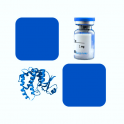
- Remove this product from my favorite's list.
- Add this product to my list of favorites.
Products
Newsletter
 |  |  |  |  |  |

Background
Protein L was isolated from the surface of bacterial species Peptostreptococcus magnus and was found to bind Ig(IgG,IgM,IgA,IgE and IgD) through L chain interaction, from which the name was suggested. Despite this wide-ranging binding capability with respect to Ig classes, Protein L is not a universal immunoglobilin-binding protein. Binding of Protein L to immunoglobulins is restricted to those containing kappa light chains (i.e., k chain of the VL domain). In humans and mice, kappa (k) light chains predominate. The remaining immunoglobulins have lambda (l) light chains. The recombinant protein contains four immunoglobulin (Ig) binding domains (Bdomains) of the native protein. Besides antibody, protein L is also suitable for binding of a wide range of antibody fragments such as Fabs, single-chain variable fragments (scFv), and domain antibodies (Dabs).
Source
Recombinant Protein L, His Tag, also known as Recombinant Peptostreptococcus magnus Protein L, was expressed in E.Coli at ACRObiosystems.
Molecular Characterization
Recombinant Protein L, His Tag is fused with the polyhistidine tag at N-terminus and a single cysteine at C-terminus. The reducing (R) protein migrates as a 45 kDa polypeptide. Protein L Protein can bind to VL-Kappa.
Endotoxin
Less than 1.0 EU per μg by the LAL method.
Purity
>95% as determined by SDS-PAGE.
Formulation
Lyophilized from 0.22 μm filtered solution in 100 mM NaH2PO4, pH8.5. Normally trehalose is added as protectant before lyophilization.
Reconstitution
See Certificate of Analysis for reconstitution instructions and specific concentrations.
Storage
For long term storage, the product should be stored at lyophilized state at -20°C or lower.
Please avoid repeated freeze-thaw cycles.
This product is stable after storage at:
-20°C to -70°C for 12 months in lyophilized state;
-70°C for 3 months under sterile conditions after reconstitution.
Bioactivity
n/a
(1) "A Case of Persistent Lung Masses After Treatment of Hodgkin Lymphoma"
Sinha, Fu, Bains et al
Chest (2024) 165 (3), e79-e84
(2) "Sensitivity analysis of the INRA 2018 feeding system for ruminants by a one-at-a-time approach: Effects of dietary input variables on predictions of multiple responses of dairy cattle"
Jeon, Lemosquet, Toulemonde et al
J Dairy Sci (2024)
(3) "Genetically encoded site-specific 19F unnatural amino acid incorporation in V. natriegens for in-cell NMR analysis"
Li, Zhang, Wang et al
Protein Expr Purif (2024)
Showing 1-3 of 613333 papers.
Welcome Login
Contact us
Follow us